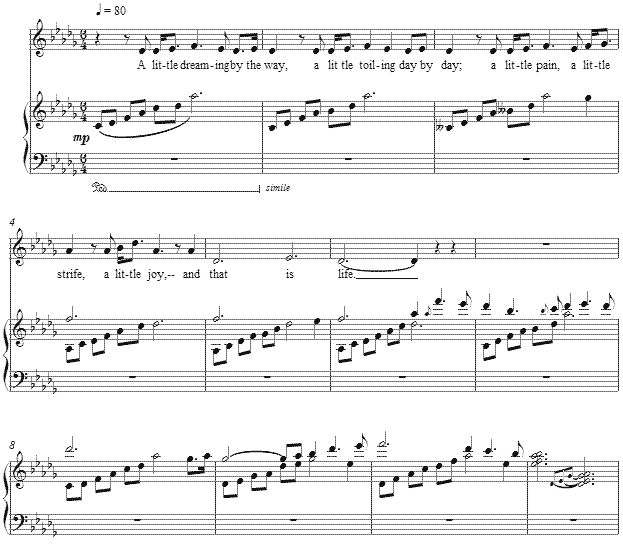Music and Texts of GARY BACHLUND
Vocal Music | Piano | Organ | Chamber Music | Orchestral | Articles and Commentary | Poems and Stories | Miscellany | FAQs
The Sum - (2009)
Paul Laurence Dunbar
for low or medium voice and piano
A little dreaming by the way,
A little toiling day by day;
A little pain, a little strife,
A little joy, -- and that is life.
A little short-lived summer's morn,
When joy seems all so newly born,
When one day's sky is blue above,
And one bird sings, -- and that is love.
A little sickening of the years,
The tribute of a few hot tears
Two folded hands, the failing breath,
And peace at last, -- and that is death.
Just dreaming, loving, dying so,
The actors in the drama go --
A flitting picture on a wall,
Love, Death, the themes; but is that all?[ 3 pages, circa 3' 20" ]
Paul Laurence Dunbar
The text is published in a collection, Lyrics of the Hearthside, 1899. Given the variety of Dunbar's philosophic statements as rendered in verse as well as in standard English as well as dialect, this opened question is among the more pensive reflections he has written. "Is that all?"
This question comes to us all, and causes me to remember a dinner I had with a colleague, friend and fine musician. In his work, he had reached the pinnacle available to him in his forties. "What was to come? Is that all there is," to which my response was a certain yes. That life is finite is a given, but that in being finite there is worth is the key. When one thinks on the story of our Papa Bach, he had achieved so much musically and yet died being thought old-fashioned, and in the hands of inept if not criminal physician. That life is finite and that we reach some kind of pinnacle, not to climb significantly higher, is a normal place in life for many.
Yet Dunbar asks the question, and our hindsight of knowing his history and personal circumstances, the answer to the question -- in one's life -- can be that "this is all there is." But beyond life, whether it take the forms and expressions of religious beliefs to the simple proof that this setting newly revisits this fine poet's work once again, the answer is also "no." There is more to life which cannot be fathomed through the eyes of mortality. This too Dunbar asserts in others of his great opus.
The harmonic rhythm is measure-long slow, as the simple chords move from statement to statement in the text. From the tonic major begun with the seventh of the scale and throughout, four-note diatonic chords in a mostly single-voiced line accompany the vocal line's details. This verse form is hymn like, with a short interlude between the stanzas.
The third stanza adds a quiet, sinking bass voice, which descends quietly by scalar steps across the octave's tonic span.
The last stanza moves from D flat to F, with an alteration to the vocal line's shape in the elongation and repetitions of Dunbar's topics, live, love, and death. A small reference to the earlier D flat major seven at measure 42 yields again to the brighter and higher F major. In answer to his question, this setting in some small way affirms that there indeed is "more," such that both answers to his query might seem appropriate, based on one's perspective and frame of reference.
The score for The Sum is available as a free PDF download, though any major commercial performance or recording of the work is prohibited without prior arrangement with the composer. Click on the graphic below for this piano-vocal score.



